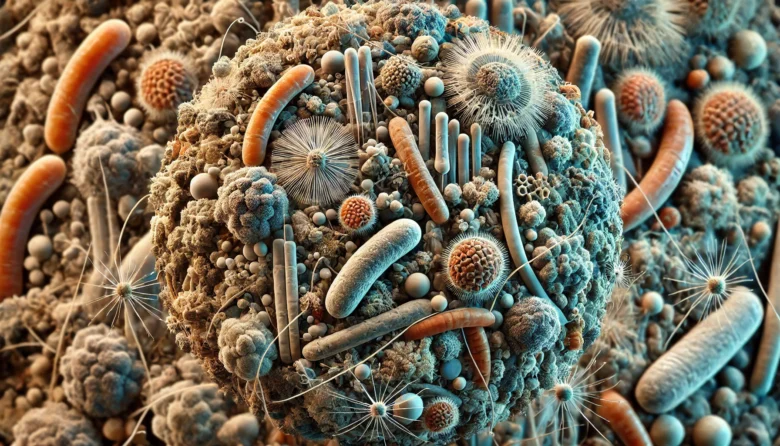Have you ever wondered what lies beneath our feet, beyond the visible roots and worms? Welcome to the hidden world of soil microbiomes. This fascinating underground network is crucial to the health of our environment and agriculture, especially here in India. Understanding soil microbiomes can transform the way we think about farming, gardening, and environmental conservation.
What is a Soil Microbiome?
A soil microbiome is a community of microorganisms, including bacteria, fungi, viruses, and other microscopic entities, that inhabit the soil. These tiny creatures might be invisible to the naked eye, but they play a massive role in maintaining soil health and fertility.
Why Should We Care About Soil Microbiomes?
Soil Health: Microbiomes are essential for nutrient cycling. They decompose organic material, releasing essential nutrients that plants require for growth. Without these microorganisms, the soil would be just dirt.
Plant Growth: Certain bacteria and fungi form symbiotic relationships with plants. For example, Rhizobium bacteria fix nitrogen in legumes, making it available for plant use. Mycorrhizal fungi extend plant roots, enhancing water and nutrient absorption.
Climate Change: Soil microbiomes can sequester carbon, helping mitigate climate change. They also influence greenhouse gas emissions from soil.
Disease Resistance: A robust soil microbiome can inhibit soil-borne diseases, thereby decreasing the necessity for chemical pesticides.

Soil Microbiomes in Indian Agriculture
India’s rich agricultural tradition relies heavily on healthy soil. However, modern farming practices, including excessive use of chemical fertilizers and pesticides, have disrupted soil microbiomes, leading to soil degradation and reduced fertility.
The Green Revolution and Its Impact
The Green Revolution of the 1960s brought high-yield crop varieties and led to increased application of chemical fertilizers and pesticides. While it boosted food production, it also led to soil health issues. Today, many farmers face challenges such as reduced soil fertility and increased pest resistance.
Embracing Sustainable Practices
To restore soil health, many Indian farmers are now turning to sustainable agricultural practices. These methods not only protect soil microbiomes but also enhance crop yields and environmental health.
Organic Farming
Organic farming avoids synthetic chemicals, promoting natural soil health. It promotes the application of compost, green manure, and crop rotation to sustain soil fertility and the diversity of the microbiome.
Zero Budget Natural Farming (ZBNF)
Pioneered by Subhash Palekar, ZBNF involves the use of natural inputs like cow dung, urine, and plant extracts. This method has shown promise in improving soil health and reducing costs for farmers.
Integrated Pest Management (IPM)
IPM combines biological, cultural, and mechanical methods to control pests. By reducing chemical use, IPM supports a balanced soil microbiome.
How Can We Support Soil Microbiomes at Home?
Even if you’re not a farmer, you can contribute to soil health in your garden. Here are some simple tips:
Composting: Create compost from kitchen waste to enrich your garden soil with organic matter.
Avoid Chemicals: Limit the use of chemical fertilizers and pesticides.
Mulching: Apply mulch to conserve soil moisture and contribute organic material as it breaks down.
Diverse Planting: Plant a variety of species to promote a diverse microbiome.
The Role of Technology
Modern technology offers new ways to study and enhance soil microbiomes. Companies like AgBiome (specializes in innovative agricultural products) and Indigo Agriculture (focuses on microbial and digital technologies for farming) are exploring microbial solutions to improve crop health and yield.
Soil Testing and Monitoring
Soil testing helps farmers understand the microbiome composition and nutrient status of their soil. This information allows for precise input management, reducing waste, and improving soil health.
Microbial Inoculants
These are preparations containing beneficial microorganisms that can be added to soil to enhance its microbiome. They are becoming increasingly popular in sustainable farming.
Challenges and Future Directions
While the benefits of a healthy soil microbiome are clear, several challenges remain:
Awareness: A significant number of farmers are not yet aware of the critical role of soil microbiomes. Education and outreach are crucial.
Research: More research is needed to understand the complex interactions within soil microbiomes.
Policy Support: Government policies should promote sustainable practices and provide support for farmers transitioning to these methods.
Conclusion
The hidden world of soil microbiomes holds the key to sustainable agriculture and environmental health. By understanding and nurturing this underground ecosystem, we can ensure a healthier future for our farms, gardens, and the planet. Whether you’re a farmer, gardener, or just someone interested in the environment, you can play a part in this exciting journey.
Author’s Note
Thank you for exploring the hidden world of soil microbiomes with me. I hope this blog has sparked your interest in the incredible, unseen life beneath our feet. Together, we can foster a healthier and more sustainable future.
G.C., Ecosociosphere contributor.




